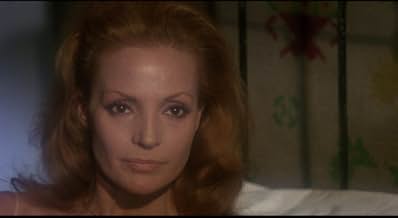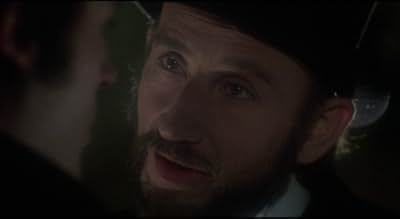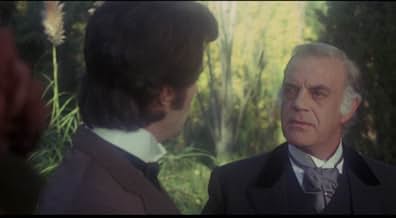Ajouter une intrigue dans votre langueA British novelist travels to Spain to visit his sister. However, when he arrives he discovers that she has been murdered by a gang of devil-worshiping bandits called the Devil's Cross.A British novelist travels to Spain to visit his sister. However, when he arrives he discovers that she has been murdered by a gang of devil-worshiping bandits called the Devil's Cross.A British novelist travels to Spain to visit his sister. However, when he arrives he discovers that she has been murdered by a gang of devil-worshiping bandits called the Devil's Cross.
- Réalisation
- Scénario
- Casting principal
Avis à la une
Obscure, strangely hard to find Spanish mid seventies movie that has been described as the unofficial fifth Blind Dead. This would be over egging things because although this solid and well made film alludes to the Templars and promises us a reprise of the zombie horsemen, in that respect this is a bit of a let down. It is a similar tale to that of the Amando de Ossorio films but despite a fine cast and decent dialogue, this is a bit too 'talky' and although we see a dream sequence of the horsemen tormenting a girl early on, it is brief and bloodless. Indeed the whole film is rather lacking in bite and the limited action half hearted. Its a shame because with everyone working so hard and the film looking so good, this could so easily have been really good.
There is some controversy surrounding this film. It was/is a Paul Naschy horror film, but in a strange turnaround, he is not in it.
He asked his friend Hammer director John Gilling to direct. It was Gilling's last film. He did it while he was on vacation in Spain.
Naschy was supposed to star, but Gilling fired him and hired someone else to do rewrites. Naschy still gets writing credits as he wrote the screenplay.
So much for friendship.
Writer Alfred Dawson (Ramiro Oliveros, who was brought in to replace Naschy) is having horrible dreams after smoking hashish. I've had those same dreams after drinking Starbucks Thanksgiving Blend very late at night.
For a horror film, it gets a slow start, absent the dreams. It's more like a telenovela until the very end. You can certainly see the British influence in what is supposed to be a Spanish film.
I have to say that Ines (Silvia Vivó) was a real tease. I kept hoping we would have something to cheer, but she died before we could. Her career was mostly TV, so we will never know what we missed.
The film really doesn't get interesting until the end, when the zombie Templars appear. We are left wondering if there was a real evil or if it was a drug-induced fantasy. Certainly, there was no doubt who killed his sister. I can't imagine a more evil character then Adolfo Marsillach.
No gore, no nudity. It was strictly a TV film.
He asked his friend Hammer director John Gilling to direct. It was Gilling's last film. He did it while he was on vacation in Spain.
Naschy was supposed to star, but Gilling fired him and hired someone else to do rewrites. Naschy still gets writing credits as he wrote the screenplay.
So much for friendship.
Writer Alfred Dawson (Ramiro Oliveros, who was brought in to replace Naschy) is having horrible dreams after smoking hashish. I've had those same dreams after drinking Starbucks Thanksgiving Blend very late at night.
For a horror film, it gets a slow start, absent the dreams. It's more like a telenovela until the very end. You can certainly see the British influence in what is supposed to be a Spanish film.
I have to say that Ines (Silvia Vivó) was a real tease. I kept hoping we would have something to cheer, but she died before we could. Her career was mostly TV, so we will never know what we missed.
The film really doesn't get interesting until the end, when the zombie Templars appear. We are left wondering if there was a real evil or if it was a drug-induced fantasy. Certainly, there was no doubt who killed his sister. I can't imagine a more evil character then Adolfo Marsillach.
No gore, no nudity. It was strictly a TV film.
This is largely a word and exposition driven film. It's slickly made and well acted, it's as slick or slicker than Gilling's Hammer films which suffer when compared to the perfectly crafted films of Terence Fisher done at the same time. He has his own style of writing and directing that does separate his work from the rest of Hammer in a unique way. So I was always wanting to see this final film.
There are few appearances of the Templars in this film and they are few and far between. The journey of the hero is to get to the spot his sister died where there is a Cross of the Devil. But it takes almost the entire length of the film to get there and people just talk and talk endlessly and when you are watching subtitles it's hard to even "watch" the nice scenery they travel through. The talk mostly is exposition about the interesting history of the Templars. But those stories all sound like they'd make better more action filled films than this one. It's not the pace of the film that's slow it's the overly talking script and lack of much real "incident" in the film. There is some nice camera movement and the few wordless moments are effective. Few scares though there is a memorable sequence with a solitary eye emerging from the shadows. Frankly that's about as exciting as the middle part of this film gets. Again as you watch just expect very few Templars and that will help some. Nice music score but there isn't much sinister or scary action of score. One assumes Naschy's original script had less talk and more action. This isn't Gilling's worst film but it's not his best. Too bad he didn't get to make more films, but you have to hope if he had they'd be more exciting than this one.
There are few appearances of the Templars in this film and they are few and far between. The journey of the hero is to get to the spot his sister died where there is a Cross of the Devil. But it takes almost the entire length of the film to get there and people just talk and talk endlessly and when you are watching subtitles it's hard to even "watch" the nice scenery they travel through. The talk mostly is exposition about the interesting history of the Templars. But those stories all sound like they'd make better more action filled films than this one. It's not the pace of the film that's slow it's the overly talking script and lack of much real "incident" in the film. There is some nice camera movement and the few wordless moments are effective. Few scares though there is a memorable sequence with a solitary eye emerging from the shadows. Frankly that's about as exciting as the middle part of this film gets. Again as you watch just expect very few Templars and that will help some. Nice music score but there isn't much sinister or scary action of score. One assumes Naschy's original script had less talk and more action. This isn't Gilling's worst film but it's not his best. Too bad he didn't get to make more films, but you have to hope if he had they'd be more exciting than this one.
Often said to be the unofficial fifth chapter in the "Blind Dead" series, John Gilling's "La Cruz del Diablo" (The Devil's Cross) easily tops his predecessors, and is among the very best horror films to have come out of Spain. The story follows a writer who has a series of drug addicted hallucinations involving the Templars. When he goes to Spain visit his sister, only to find that she died by the time he got there, he decides to investigate, and tries to find a connection between her death and his horrifying visions. While many have called it a mere cash-in on Amando de Ossorio's infamous series, it's actually a much more accurate and throughly superior adaptation of the writings of Gustavo Adolfo Bécquer, which also served as inspiration for "Tombs of the Blind Dead". Like Béquer, less emphasis is given to the Templars themselves, and the whole affair is more of a character-driven piece, that is not devoid of symbolism and ambiguity. I have to give credit to Ossorio, since his Templars are much creepier than those presented here, but I liked how Gilling went for something different, and kept them more in the shadows. Originally intended as a Paul Naschy vehicle, one can clearly see how this could've become just another 70's Spanish horror, but Gilling's direction makes the total difference. A Hammer Horror veteran, Gilling combines the more sophisticated, polished style of his British contemporaries and combines it with the more raw, grittier appeal of Spanish Gothic. There's a bit of Italian horror in there as well, "Kill Baby ... Kill!" and "Castle of Blood" to be more precise, and one can argue that the black-gloved killer is a nod to gialli. Judging from this combination, it is suffice to say that the visuals are simply jaw-dropping, making great use of the beautiful Spanish locations, which land to the ever-present fairytale-ish aspects of Bécquer's work, as well the use of actual ruins and atmospheric, candle-lit interiors. The sometimes eerie, sometimes romantic score by Ángel Arteaga matches the off-beat yet strangely poetic tone perfectly. The acting is also surprisingly decent, with a cast of familiar faces from the continental horror scene of the 70's. Ramiro Oliveros and Emma Cohen, who already acted together the previous year in Jess Franco's excellent "The Other Side of the Mirror" are particularly remarkable as the drug-addicted protagonist and his ghost lover respectively, although one cannot help but wonder how would Naschy turn out in the former's role. Carmen Sevilla makes for a strong and likable heroine, and Eduardo Fajardo is good too, although he seems to be playing Francis Lehar from "Lisa and the Devil" all over again (ironically, the way his corpse is positioned near the ending is almost exactly the same as in "Lisa". The highlight among the performers is certainly Adolfo Marsillach as the mysterious assistant to Fajardo's character. He has screen presence to boot, and is just so effortlessly creepy in his relatively low-key performance. There are no big flaws in the film as far as I'm concerned, although one could argue to that the final battle between the protagonist and the Templars is somewhat anti-climatic, and the pace might be a little too slow (think "The House with Laughing Windows"). Overall, an excellent and extremely underrated horror film worthy of rediscovery. Fans of Gothic horror and slow-burns just can't afford to miss it.
Cross of the Devil (1975) is a Spanish film 🇪🇸 currently streaming on Tubi. The story follows a British writer who travels to Spain to visit his sister, only to discover she has been murdered by a local cult. Determined to uncover the truth and seek justice, he dives into the mysterious events surrounding her death.
Directed by John Gilling (The Pirates of Blood River), the film stars Ramiro Oliveros (The Swamp of the Ravens), Carmen Sevilla (King of Kings), Adolfo Marsillach (The Black Tulip), and Emma Cohen (Novela).
This is an enjoyable film that delivers some unexpected twists. The period attire, detailed sets, and effective props draw you into the era, while the use of smoke machines enhances the atmosphere. The flashback sequences are engaging, and the cult scenes are suitably eerie. The background sound effects also contribute to the film's mood. Most of the action occurs at the beginning and end, but the story remains entertaining as it unfolds. The conclusion, with its unexpected sword duel, has a Three Musketeers vibe that adds a unique touch.
In conclusion, Cross of the Devil isn't flawless but stands out as a fun and distinctive film from its era. I'd rate it 6/10 and recommend it to fans of vintage cinema.
Directed by John Gilling (The Pirates of Blood River), the film stars Ramiro Oliveros (The Swamp of the Ravens), Carmen Sevilla (King of Kings), Adolfo Marsillach (The Black Tulip), and Emma Cohen (Novela).
This is an enjoyable film that delivers some unexpected twists. The period attire, detailed sets, and effective props draw you into the era, while the use of smoke machines enhances the atmosphere. The flashback sequences are engaging, and the cult scenes are suitably eerie. The background sound effects also contribute to the film's mood. Most of the action occurs at the beginning and end, but the story remains entertaining as it unfolds. The conclusion, with its unexpected sword duel, has a Three Musketeers vibe that adds a unique touch.
In conclusion, Cross of the Devil isn't flawless but stands out as a fun and distinctive film from its era. I'd rate it 6/10 and recommend it to fans of vintage cinema.
Le saviez-vous
- AnecdotesThis was prolific director John Gilling's last film. He hadn't planned to make it, but he was on vacation in Spain when his friend, actor/director Paul Naschy, asked him to direct it for him.
- ConnexionsReferenced in Rojo sangre (2004)
Meilleurs choix
Connectez-vous pour évaluer et suivre la liste de favoris afin de recevoir des recommandations personnalisées
Détails
- Durée
- 1h 32min(92 min)
- Mixage
- Rapport de forme
- 1.85 : 1
Contribuer à cette page
Suggérer une modification ou ajouter du contenu manquant


























